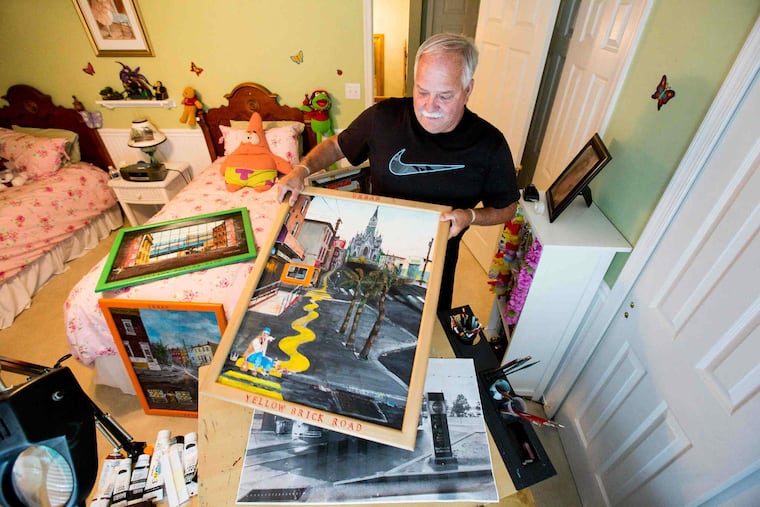Big dreams for blue-collar Bucks painter
W. Paul Galiczynski, 60, owns a concrete shop in Kensington but hopes his paintings will someday hang in the art world's most-hallowed halls.

A crooked barn in Bucks County always catches artist W. Paul Galiczynski's eye when he passes by in his pickup.
The Washington Crossing resident said he might paint it someday. Then he hedged. He probably won't. Maybe if it fell down or caught fire.
"Everybody paints barns," he said.
Galiczynski, 60, makes concrete patios and stoops by day. He has the hands to prove it. When he's really busy, he writes customers' phone numbers on his leg with a marker. When it's slow, he locks up his shop in Kensington and fishes for catfish with chicken livers behind a sandwich shack on the Delaware.
"I honestly don't even know whose number that is," he said of the scrawl on his thigh.
When he's in his Nike T-shirt and sneakers, most art galleries would assume he's there to paint the ceiling, perhaps, not to hang his collection. His version of a wine-and-cheese still life is Herr's cheese curls and a can of Ortlieb's; street portraiture is the inflatable union rat with bloody fangs. As W.P. Galiczynski, he has painted both tableaux in bold, simple acrylics as part of his Urban Series, which recently finished a run at InLiquid Hall Gallery at the Crane Arts Building in North Philly.
Galiczynski has caught the eye of art-school types.
"I think what he does is absolutely what art is supposed to be," said former painter, now videographer, John Thornton of Ocean City, N.J. "He's a great outsider. He captures Philadelphia so beautifully."
Though he lives the pastoral life in Bucks and adores the Wyeths, Galiczynski doesn't paint plein air, outdoors among wildflowers. He works at night among toys in his grandkids' bedroom at his townhouse, listening only to Pink Floyd. He paints public rec pools, an open fire hydrant, Mister Softee, and the facade of a Kensington exterminating company.
"Anybody can paint a tree," he said.
Born and raised in Olde Kensington at Fourth and Girard, Galiczynski spent his youth rooting around old brick buildings and hopping the trolley to a Norman Rockwell museum downtown. He doodled and daydreamed and during summers at a Catholic camp in Montgomery County fell hard for nature.
At North Catholic High School, Galiczynski left early in the afternoons to work in concrete with Uncle John in Kensington. Uncle John supposedly cut off a thief's finger once after catching him in the warehouse. Then he threw it at him.
"You can't do that stuff today," Galiczynski said, laughing.
His mother, Connie, painted portraits, and his brother, Steve, is an artist, too, but art school never crossed Galiczynski's mind. He was interested in trees and enrolled in a forestry program at Pennsylvania State University Mont Alto in Franklin County. He wanted to fight forest fires.
"I was supposed to go out to Montana and become a smoke jumper, but my wife didn't want me to jump out of an airplane," he said.
Galiczynski and his wife, Vicki, bought a five-acre alfalfa farm in Newtown after their marrying. He carved out a pond in the back with a bulldozer, and the beavers, frogs, and snakes came. The couple stayed 25 years and raised four kids there, rural enough for wholesome trouble.
Thornton, who attended the Pennsylvania Academy of the Fine Arts, said Galiczynski could have been a "fourth-rate Wyeth" had he not embraced his own odd angles. The two made a video together, with his favorite Pink Floyd song, "Shine on You Crazy Diamond," in the background.
"He's not academically perfect, but it's perfect," Thornton said.
Galiczynski can emulate the masters, too. It's not that hard, he said. That might sound conceited if someone less scrappy and likable said it.
"See, this is a Wyeth I did," he said, holding up a copy of N.C. Wyeth's The Indian in His Solitude. "I just painted Johnny Depp into it."
Philly has been the real inspiration lately. After all those hours at the shop on Stella Street, the rowhouses and refineries just grab him more than brooks and barns.
"Hello, Paul's," he says by the garage door there after his Floyd ringtone goes off. "Damn telemarketers."
One could imagine an artists' collective hobbling away there, but for Galiczynski, it's just a warehouse. Bricks are stacked by bags of sand, and every shape of shovel lines the walls. In the office, concrete dust cakes the phone, television, and everything else, and why bother dusting?
In a closet, there are a dozen hockey sticks, plus skis and fishing rods.
"You never know," he said.
Galiczynski wouldn't mind dropping the wheelbarrow and hanging up the concrete float. He'll pass the sledgehammer to his sons. He has bigger dreams, in Philly and beyond.
"I want to wind up in the Met or the Philadelphia Museum of Art," he said.
And W.P. Galiczynski won't be there to paint the bathrooms.